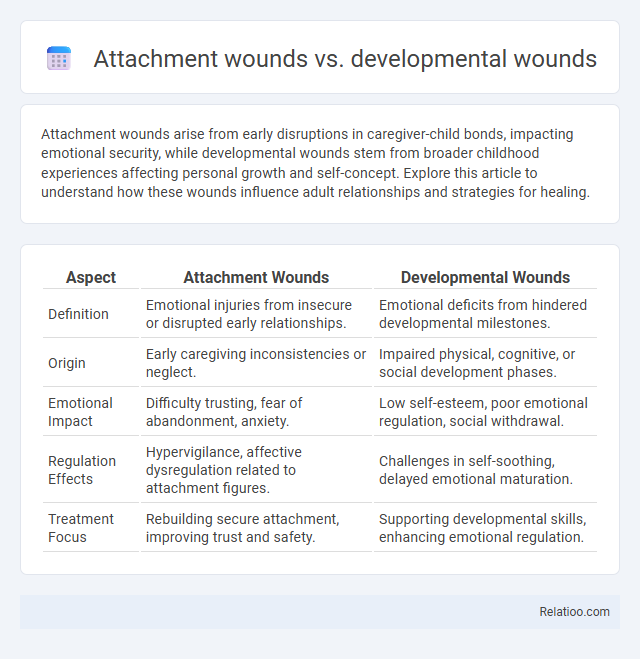Attachment wounds arise from early disruptions in caregiver-child bonds, impacting emotional security, while developmental wounds stem from broader childhood experiences affecting personal growth and self-concept. Explore this article to understand how these wounds influence adult relationships and strategies for healing.
Table of Comparison
| Aspect | Attachment Wounds | Developmental Wounds |
|---|---|---|
| Definition | Emotional injuries from insecure or disrupted early relationships. | Emotional deficits from hindered developmental milestones. |
| Origin | Early caregiving inconsistencies or neglect. | Impaired physical, cognitive, or social development phases. |
| Emotional Impact | Difficulty trusting, fear of abandonment, anxiety. | Low self-esteem, poor emotional regulation, social withdrawal. |
| Regulation Effects | Hypervigilance, affective dysregulation related to attachment figures. | Challenges in self-soothing, delayed emotional maturation. |
| Treatment Focus | Rebuilding secure attachment, improving trust and safety. | Supporting developmental skills, enhancing emotional regulation. |
Understanding Attachment Wounds
Attachment wounds originate from disruptions in early caregiver-child relationships, impacting emotional regulation and interpersonal trust throughout life. Unlike developmental wounds, which stem from broader adverse experiences affecting growth milestones, attachment wounds specifically impair the ability to form secure emotional bonds. Wounding encompasses both attachment and developmental injuries, but understanding attachment wounds is crucial for addressing relational trauma and fostering secure attachment patterns in therapy.
Defining Developmental Wounds
Developmental wounds stem from early disruptions in childhood, affecting emotional growth and forming the foundation for maladaptive patterns later in life. Unlike attachment wounds, which specifically relate to disruptions in the caregiver-child bond, developmental wounds encompass broader challenges such as neglect, abuse, or inconsistent nurturing that hinder overall psychological development. Understanding developmental wounds is crucial for targeted therapeutic interventions aimed at healing deep-seated vulnerabilities and promoting healthy emotional resilience.
Core Differences Between Attachment and Developmental Wounds
Attachment wounds originate from disruptions in early caregiver relationships, impacting Your ability to form secure emotional bonds, while developmental wounds stem from broader environmental factors affecting overall growth and psychological development. Core differences lie in attachment wounds targeting relational security and trust issues, whereas developmental wounds influence cognitive, emotional, and social milestones. Understanding these distinctions guides targeted therapeutic approaches for healing relational trauma versus addressing broader developmental challenges.
Origins and Causes of Attachment Wounds
Attachment wounds originate from unmet emotional needs or inconsistent caregiving during early childhood, impacting the child's sense of security and trust. Developmental wounds arise from broader disruptions in growth milestones, often due to trauma, neglect, or adverse environments affecting physical, cognitive, or emotional development. Wounding refers to any psychological or emotional injury, including but not limited to attachment and developmental wounds, caused by negative experiences throughout life.
How Developmental Wounds Form in Childhood
Developmental wounds form in childhood through repeated unmet emotional needs, inconsistent caregiving, or traumatic experiences that disrupt a child's sense of safety and self-worth. These wounds impact emotional regulation, attachment patterns, and relational trust, shaping your long-term psychological development. Unlike attachment wounds tied specifically to caregiver bonds or general wounding from acute trauma, developmental wounds emerge from ongoing environmental and relational deficiencies during critical growth stages.
Signs and Symptoms of Attachment Wounds
Attachment wounds manifest through difficulties in forming secure emotional bonds, characterized by symptoms such as distrust, emotional withdrawal, and heightened anxiety in relationships. In contrast, developmental wounds involve disrupted growth stages leading to issues like impaired self-esteem and cognitive delays, while general wounding may reflect physical or emotional trauma with varied psychological effects. Key signs of attachment wounds include avoidance of closeness, hypersensitivity to rejection, and difficulty regulating emotions, which distinguish them from other types of developmental or traumatic injuries.
Identifying Developmental Wound Patterns
Developmental wound patterns often originate from early childhood experiences affecting emotional growth and self-esteem, unlike attachment wounds which stem from disrupted caregiver bonds, or general wounding caused by acute trauma. Recognizing these patterns involves observing persistent feelings of worthlessness, chronic insecurity, or difficulties forming healthy identities that impede Your personal development. Identifying these signs is crucial for targeted therapeutic interventions that promote healing and emotional resilience.
Impact on Adult Relationships and Emotional Health
Attachment wounds stem from early caregiver interactions, leading to difficulties in trust and intimacy within adult relationships. Developmental wounds arise from unmet emotional needs during key growth phases, often causing challenges in self-esteem and emotional regulation. Understanding these wounds helps you recognize patterns affecting your emotional health and fosters healing through targeted therapeutic approaches.
Healing Strategies for Attachment and Developmental Wounds
Attachment wounds arise from disruptions in early caregiver relationships, while developmental wounds stem from broader emotional or environmental deficits during formative years; healing strategies for attachment wounds emphasize rebuilding trust and secure connections through consistent, empathetic relational experiences. Developmental wound healing focuses on nurturing self-regulation and emotional resilience by integrating therapeutic techniques such as cognitive-behavioral therapy, somatic experiencing, and supportive environments that address developmental trauma. Both approaches prioritize creating safe spaces for emotional expression and cultivating adaptive coping skills to foster psychological growth and stability.
Professional Support and Therapeutic Approaches
Professional support for Attachment Wounds often involves trauma-informed therapy such as Eye Movement Desensitization and Reprocessing (EMDR) and attachment-based psychotherapy to rebuild trust and emotional regulation. Developmental Wounds require integrative approaches like cognitive-behavioral therapy (CBT) combined with developmental psychology insights to address early life disruptions impacting self-concept and interpersonal skills. Therapeutic interventions for Wounding, including somatic experiencing and emotion-focused therapy (EFT), target both psychological and physiological responses to trauma for comprehensive healing outcomes.

Infographic: Attachment Wounds vs Developmental Wounds
 relatioo.com
relatioo.com